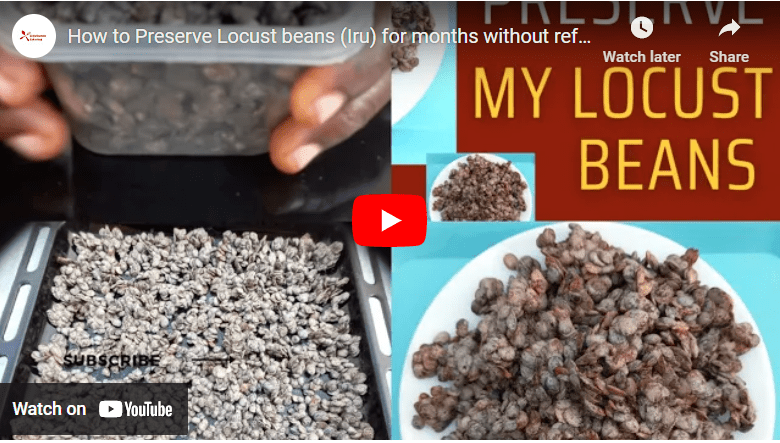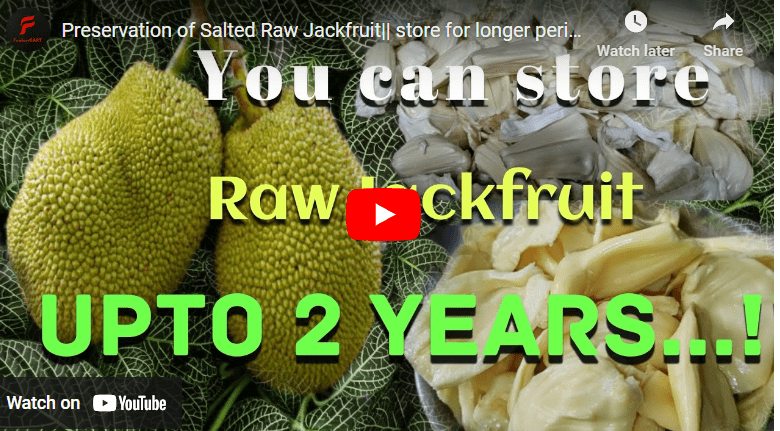Locust beans are a popular ingredient used in many West African dishes for their unique flavor and nutritional benefits. However, due to their seasonal nature, preserving them is essential to ensure their availability year-round.
Preserving locust beans is not only beneficial for home use but also for commercial purposes. The traditional method of sun-drying is the most common preservation method, but there are other effective methods such as smoking and freezing.
There are several methods you can use to keep locust beans for months or even years. To keep locust beans for a long time, make sure to store them in an airtight container in a cool, dry place. Additionally, you can freeze locust beans to maintain freshness.
If you want to extend the shelf life of locust beans, you can also store them in a mixture of salt and ash for up to six months. Follow these steps to ensure the best results for long-term storage of locust beans.
How To Preserve Locust Beans
Locust beans are a type of legume commonly used in West African cuisine. They are known for their strong, unique flavor and high nutritional value, and are used in soups, stews, sauces, and other dishes. They are also popularly used as a seasoning or condiment.
Read Also: How To Preserve Aloe Vera For Long-Time Storage
If you purchase or harvested surplus locust beans than you can use, here are 4 proven methods on how you can preserve the beans from spoiling and for future use.
#1. Methods of Preserving Locust Beans: Traditional Sun-Drying Method
To preserve locust beans using the traditional sun-drying method, follow these steps:
Step 1 – Wash and Clean The Beans
Rinse the beans thoroughly in clean water to remove any dirt or debris. You can use a sieve or strainer to do this effectively.
Read Also: How To Preserve Apple for Long-Time Storage
Step 2 – Spread The Beans Out
Spread the clean beans out on a clean mat or flat surface in a well-ventilated area, preferably under direct sunlight. You can also use a clean tray or basket lined with a clean cloth or paper towel.
Step 3 – Turn The Beans Regularly
To ensure even drying, turn the beans over regularly with a wooden spoon or clean hand. This will allow all parts of the beans to dry out and prevent mold growth.
Read Also: How To Preserve Kiwi For Long Time Storage
Step 4 – Cover the beans at night
At night, cover the beans with a clean cloth or net to protect them from dew or insects.
Read Also: How To Preserve Avocado For Long Time Storage
Step 5 –Check For Dryness
After about 4 to 5 days, check to see if the beans are completely dry. You can test this by breaking one of the beans. If it snaps easily and cleanly, it is dry. If it bends or feels soft, it needs more time to dry.
Step 6 –Store The Dried Beans
Once the beans are dry, remove any remaining debris or chaff, and store them in an airtight container in a cool, dry place.
Advantages
- Simple And Inexpensive Method: This method does not require any special equipment or technology, making it a cost-effective way to preserve locust beans.
- Retains Nutritional Value: Sun-drying is a gentle method of preservation that can help retain the nutritional value of the beans.
- Produces A Unique Flavor: Sun-dried locust beans have a unique flavor that is different from beans preserved using other methods, which some people prefer.
- Long Shelf Life: Properly sun-dried beans can have a shelf life of up to one year.
Read Also: How To Preserve Beans For Long Time Storage
Disadvantages
- Weather Dependent: Sun-drying is highly dependent on weather conditions, such as sunny and dry weather, making it challenging in areas with high humidity or rainy seasons.
- Risk of Contamination: The beans can be exposed to dust, dirt, insects, and other contaminants during the drying process, which can affect the quality and safety of the preserved beans.
- Requires a Large Drying Area: To effectively sun-dry a significant amount of beans, a large drying area is required, which may not be available in some areas.
- Can Take a Long Time: Sun-drying can take several days to complete, which may not be practical for people who need the beans quickly.
It is important to note that traditional sun-drying can take longer depending on the weather conditions and the moisture content of the beans. You can also use a food dehydrator to speed up the drying process.
Read Also: How To Preserve Cabbage For Long Storage
#2. Methods Of Preserving Locust Beans: Smoking Method
To preserve locust beans using the smoking method, follow these steps:
Step 1 –Wash And Clean The Beans
Rinse the beans thoroughly in clean water to remove any dirt or debris. You can use a sieve or strainer to do this effectively.
Step 2 –Prepare The Smoking Chamber
Build a smoking chamber using a large pot or drum, a perforated metal sheet or wire mesh, and some firewood or sawdust. Place the perforated metal sheet or wire mesh at the bottom of the pot or drum and fill it with firewood or sawdust.
Step 3 –Heat The Smoking Chamber
Light the firewood or sawdust and wait for it to start smoldering. When the smoke starts to rise, reduce the heat to a low to medium level.
Read Also: How To Preserve Carrot For Long Time Storage
Step 4 – Add the beans to the smoking chamber
Place the clean beans on the perforated metal sheet or wire mesh in the smoking chamber. Be careful not to overload the chamber and leave some space for smoke to circulate.
Step 5 – Smoke the beans
Cover the pot or drum with a lid or foil to trap the smoke inside. Smoke the beans for 2 to 3 hours or until they are completely dry and have a deep brown color. Turn the beans over every 30 minutes to ensure even smoking.
Step 6 – Cool and store the beans
Once the beans are dry, remove them from the smoking chamber and allow them to cool. Remove any remaining debris or chaff and store them in an airtight container in a cool, dry place.
Read Also: How to Preserve Cocoa for Long Time Storage
Advantages
- Adds A Unique Smoky Flavor: The smoking process gives locust beans a unique, smoky flavor that can add depth and complexity to dishes.
- Long Shelf Life: Properly smoked beans can have a shelf life of up to one year.
- Simple Method: This method does not require any special equipment or technology, making it a cost-effective way to preserve locust beans.
- Can Help Repel Insects: Smoking the beans can help repel insects and pests, which can reduce the risk of spoilage and contamination.
Disadvantages
- Time-consuming: Smoking can be a time-consuming process, taking up to several days to complete.
- Weather Dependent: Like sun-drying, smoking is highly dependent on weather conditions, such as dry weather, which may not be available in some areas.
- Risk of Contamination: The beans can be exposed to smoke residue and other contaminants during the smoking process, which can affect the quality and safety of the preserved beans.
- Can be too Smoky: If the beans are smoked for too long or at too high of a temperature, they can become overly smoky, making them unpleasant to eat.
It is important to note that the smoking method may result in a smoky flavor and aroma, which can be desirable for some dishes but not for others. Adjust the smoking time and level of heat to achieve the desired result.
Read Also: How To Preserve Coconut For Long-Time Storage
#3. Methods of preserving locust beans: Freezing Method
To preserve locust beans using the freezing method, follow these steps:
Step 1 – Wash And Clean The Beans
Rinse the beans thoroughly in clean water to remove any dirt or debris. You can use a sieve or strainer to do this effectively.
Step 2 –Blanch The Beans
Bring a large pot of water to a boil and add the clean beans. Blanch the beans for 3 to 5 minutes or until they turn bright green. This will help to retain both the color and texture of the locust beans.
Step 3 – Cool And Dry The Beans
Remove the beans from the boiling water and immerse them in a bowl of ice water to stop the cooking process. Drain the beans and spread them out on a clean towel or paper towel to dry.
Step 4 – Pack The Beans
Once the beans are dry, pack them into airtight containers or freezer bags. After packing the beans, ensure you label the containers writing the date and contents.
Read Also: How To Preserve Cucumber For Longer Storage
Step 5 – Freeze the beans
Place the packed containers in the freezer and freeze them at a temperature of 0°F (-18°C) or lower.
Step 6 – Thaw and use the beans
To use the frozen beans, remove them from the freezer and allow them to thaw in the refrigerator or at room temperature. You can then use them in your favorite dishes.
Advantages
- Retains Nutritional Value: Freezing is a gentle method of preservation that can help retain the nutritional value of the beans.
- Convenient And Quick: Freezing is a quick and convenient method that can be done at any time of the year, regardless of weather conditions.
- Minimal Risk Of Contamination: Freezing the beans can help minimize the risk of contamination and spoilage.
- Can Be Done In Small Quantities: This method is suitable for preserving small quantities of beans, which can be useful for home use.
Read Also: How To Preserve Flowers
Disadvantages
- Requires A Freezer: The freezing method requires access to a freezer, which may not be available in some areas or for people with limited resources.
- Quality May Be Affected: The quality of the beans may be affected by the freezing process, as they can become mushy or lose their texture.
- Shorter Shelf Life: Frozen beans have a shorter shelf life compared to beans preserved using other methods, typically only lasting up to six months.
- Can Be Expensive: Freezing can be expensive in terms of energy usage and electricity bills, which may not be feasible for some people.
It is important to note that frozen locust beans may lose some of their texture and flavor after being frozen and thawed. Therefore, it is recommended to use them within six months of freezing. You can also add some salt to the blanching water to enhance the flavor of the beans.
#4. Methods Of Preserving Locust Beans: Salting Method
To preserve locust beans using the salting method, follow these steps:
Step 1 –Wash And Clean The Beans
Rinse the beans thoroughly in clean water to remove any dirt or debris. You can use a sieve or strainer to do this effectively.
Read Also: How To Preserve Fresh Pepper For Long-Time Storage
Step 2 –Add Salt To The Beans
Place the clean beans in a bowl or container and add salt to them. Use about 1 tablespoon of salt for every cup of beans.
Step 3 –Mix The Beans And Salt
Mix the beans and salt together well, making sure that the salt is evenly distributed.
Step 4 –Pack The Beans
Once the beans are mixed with salt, pack them into a clean, sterilized jar or container. Be sure to press down on the beans to remove any air pockets.
Step 5 –Cover And Store The Beans
Cover the jar or container tightly with a lid or plastic wrap. Store the beans in a cool, dry place for at least two weeks.
Step 5 –Rinse And Use The Beans
After two weeks, rinse the beans thoroughly in clean water to remove any excess salt. You can then use the beans in your favorite dishes.
Read Also: How to Preserve Tomatoes for Long Time Storage
Advantages
- Long Shelf Life: Properly salted beans can have a shelf life of up to one year.
- Requires Minimal Equipment: The salting method only requires a container, salt, and the beans, making it a cost-effective way to preserve locust beans.
- Retains Flavor: The salt helps to preserve the flavor of the beans, making them taste similar to fresh beans.
- Low Risk Of Spoilage: The high salt concentration in the beans helps to reduce the risk of spoilage and contamination.
Disadvantages
- High Salt Content: The high salt content of the beans may make them unsuitable for people with high blood pressure or other health conditions.
- Time-Consuming: The salting process can take several days to complete, and requires frequent stirring and monitoring to ensure proper preservation.
- Requires Careful Rinsing: The beans need to be carefully rinsed to remove excess salt before use, which can be time-consuming and require additional equipment, such as a strainer or colander.
- Flavor May Be Affected: The salt may affect the flavor of the beans, making them saltier than fresh beans.
It is important to note that the salting method may result in a salty flavor, so adjust the amount of salt to your liking. You can also add some spices or herbs to the beans to enhance their flavor. Additionally, be sure to use a clean, sterilized jar or container to prevent contamination.
Read Also: How To Preserve Garlic For Long Time Storage
Best Practices For Preserving Locust Beans
To ensure the best preservation of your locust beans, follow these best practices:
1 –Sort And Clean The Beans
Sort out any damaged, immature, or discolored beans. Rinse the beans thoroughly in clean water to remove any dirt or debris.
2 –Choose The Right Preservation Method
Select the preservation method that works best for you based on your storage needs, equipment, and personal preferences.
3 –Use Clean And Sterilized Equipment
When preserving locust beans, it is important to use clean and sterilized equipment. This will prevent contamination and ensure the best quality of preserved beans.
4 –Store In A Cool, Dry Place
Store the preserved locust beans in a cool, dry place away from direct sunlight. This will prevent spoilage and ensure the longest shelf life.
5 –Label And Date The Containers
Label the containers with the date and contents. This will help you keep track of the age of the beans and ensure that you use the oldest beans first.
Read Also: How To Preserve Ginger For Long Time Storage
6 –Use within recommended time frame
Each preservation method has a recommended time frame for storage. Be sure to use the preserved beans within the recommended time frame to ensure the best quality and flavor.
By following these best practices, you can ensure that your locust beans are preserved properly and have the best flavor and texture when used in your favorite dishes.
Using Preserved Locust Beans
Here are step-by-step instructions for using preserved locust beans
Step 1 – Rinse The Beans
Depending on the preservation method used, you may need to rinse the beans before use to remove any excess salt or smoke residue.
Step 2 –Soak The Beans
If you are using the sun-dried or frozen method, soak the beans in water overnight or for several hours until they become soft.
Step 3 –Mash or grind the beans
Once the beans are soft, you can mash them with a mortar and pestle or grind them in a food processor. This will create a paste-like consistency that can be used in various dishes.
Step 4 –Use in your favorite dishes
Preserved locust beans can be used in a variety of dishes, including soups, stews, sauces, and dips. They can add a rich, savory flavor to your meals and can be used as a substitute for bouillon cubes or seasoning.
Read Also: How To Preserve Lemon For Long Time Storage
Step 5 –Store leftover beans
If you have any leftover preserved beans, store them in a clean, airtight container in the refrigerator or freezer for later use.
Fermentation Of Locust Beans
Fermentation is a traditional method of preserving locust beans that has been used for centuries. To ferment locust beans, start by washing the beans and removing any debris or impurities.
Next, place the beans in a bowl or container and cover them with water. Allow the beans to soak for 1-2 days, changing the water every 12 hours.
After soaking, drain the beans and place them in a pot. Add water and cook the beans until they are soft and mushy. Stir the beans frequently to prevent them from burning or sticking to the pot.
Once the beans are cooked, transfer them to a container and cover them with a lid. Allow the beans to ferment for 2-3 days, stirring them once a day. The fermentation process will cause the beans to become soft and acquire a unique flavor and aroma.
Read Also: How to Preserve Ogbono For Long Storage
Spiritual Benefits Of Locust Beans
In some cultures, locust beans are believed to have spiritual benefits. For example, in Nigeria, the Yoruba people use locust beans as a symbol of good luck and prosperity.
They believe that eating locust beans can bring good fortune and ward off evil spirits. Additionally, some people believe that burning locust beans can be used to purify the air and ward off negative energy.
Read Also: How To Preserve Green Peas For Long Time Storage
Types Of Locust Beans
There are several types of locust beans available, including African locust beans, néré beans, and dawadawa. African locust beans are the most widely used and are native to West Africa. Néré beans are found in Central and West Africa and are smaller than African locust beans. Dawadawa is a type of locust bean that is commonly used in Ghana and Nigeria.
How To Use Locust Beans To Cook
Locust beans can be used in a variety of dishes to add flavor and nutrition. They are commonly used in soups, stews, and sauces, and can also be added to rice dishes and vegetable dishes.
Read Also: How To Preserve Green Beans For Long Time Storage
To use locust beans in cooking, start by washing the beans and removing any debris.
Next, soak the beans in water for a few hours to soften them. Then, add the beans to your dish and cook them until they are soft and mushy.
Locust beans can also be ground into a powder and added to dishes as a seasoning.
Read Also: How to Preserve Irish Potatoes For Long Time Storage
How To Make Locust Beans Powder
To make locust bean powder, start by washing the beans and removing any debris or impurities. Next, soak the beans in water for a few hours to soften them.
Drain the beans and spread them out on a tray or baking sheet. Allow the beans to dry in the sun or in a dehydrator until they are completely dry and crispy.
Once dry, grind the beans into a fine powder using a blender or food processor. Store the powder in an airtight container and use it as a seasoning in your favorite dishes.
Read Also: How To Preserve Lettuce For long Time Storage
Locust Beans In Igbo
Locust beans, also known as iru, dawadawa or ogiri, is a traditional seasoning used in Igbo cuisine. In Igbo, it is referred to as “ogiri Igbo” and is an important ingredient in many local dishes. It is made by fermenting the seeds of the locust bean tree and has a strong, pungent aroma and flavor that is similar to soy sauce.
Uses Of Locust Beans
Locust beans are a versatile ingredient that can be used in a variety of dishes. It is commonly used as a seasoning in soups, stews, and sauces and is also used to flavor rice dishes and vegetable dishes.
It is particularly popular in West African cuisine and is used in dishes such as egusi soup, jollof rice, and efo riro. Additionally, locust beans can be ground into a powder and used as a seasoning.`
Locust Beans In Igbo
In Igbo cuisine, locust beans are a popular seasoning that is used to add flavor to many local dishes.
It is particularly popular in dishes such as egusi soup, ofe nsala, and ugba. In egusi soup, it is used to add depth of flavor and richness to the soup.
Read Also: How To Preserve Jackfruit For Long Time Storage
In ofe nsala, it is used to add a savory, umami flavor to the soup. Ugba, which is a salad made with sliced oil bean, is often seasoned with locust beans to add flavor and aroma.
Conclusion
Preserving locust beans is a simple and effective way to ensure their availability and enjoy their unique taste and nutritional benefits year-round. Traditional sun-drying, smoking, and freezing are all effective methods of preservation, each with its advantages and disadvantages.
However, regardless of the preservation method used, it is essential to follow best practices such as choosing high-quality beans, cleaning and preparing them properly, and ensuring proper storage conditions.





Good job. Thanks a bunch
You are welcome